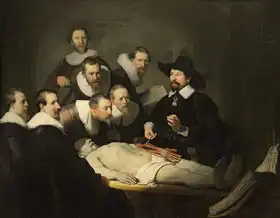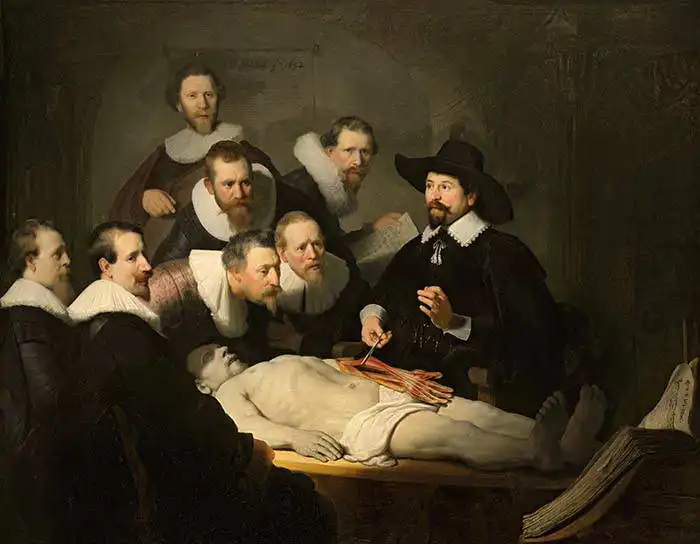About this finishing
Print. The image is printed on the top quality 10-ink HP Z9PS printer on HP matte 270 g / m2 paper. You can choose any size to an accuracy of 1 cm. A margin of 5 cm around the image is added to the size of the motif.


You can find a detailed description about our finishings
here.
Anatomy Lesson of Dr. Nicolaes Tulp
Date:
1632Medium:
oil on canvasLocation:
Mauritshuis, The Hague, The NetherlandsDimensions:
169.5 x 216"The Anatomy Lesson of Dr. Nicolaes Tulp" is an oil painting by
the Dutch painter Rembrandt Harmenszoon van Rijn , created in 1632. This painting is one of Rembrandt's famous works and depicts an event that had great historical and artistic significance.
The picture shows Dr. Nicolaes Tulp, a prominent Amsterdam physician, conducting an anatomy lesson on the severed stump of a man. He is engaged in a detailed examination of the arm of a dead body, surrounded by a group of doctors and medical students who are watching the lesson intently. Tulp holds a surgical instrument and points to the muscles in his arm.
In this painting, Rembrandt focused on the depiction of light and shadow, which creates a dramatic effect and an emphasis on detail. In addition to the anatomical lesson itself, the social and societal aspect of this event is also emphasized, where doctors and students receive new knowledge.
The painting "The Anatomy Lesson of Dr. Nicolaes Tulp" is a remarkable example of Rembrandt's mastery in depicting figures, expressions and atmosphere. It is one of his most distinguished works and shows his ability to combine art and science, making it an important work of the Dutch Golden Age and European
baroque .
Rembrandt painted picture Anatomy Lesson of Dr. Nicolaes Tulp in 1632. Prevailing color of this fine art print is dark and its shape is landscape. Original size is 169.5 x 216. This art piece is located in Mauritshuis, The Hague, The Netherlands. This image is printed on demand - you can choose material, size and finishing.
Rembrandt Harmenszoon van Rijn (1606-1669). Dutch painter considered one of the greatest painters of all time, who particularly affected the history of art. Already during his lifetime, he achieved great renown - he painted famous contemporaries and taught dozens of outstanding painters. He often painted biblical themes (for example,
Storm at Sea of Galilee or observations of the Jewish community in Amsterdam). His most famous and popular work is
Night Watch - the military retinue of Captain Frans Banning. The painting was named by its discoverer Sir Joshua Reynolds for its dark colour (the picture is, in fact, full of daylight). Another of his beautiful paintings is worth mentioning:
Return of the Prodigal Son.


